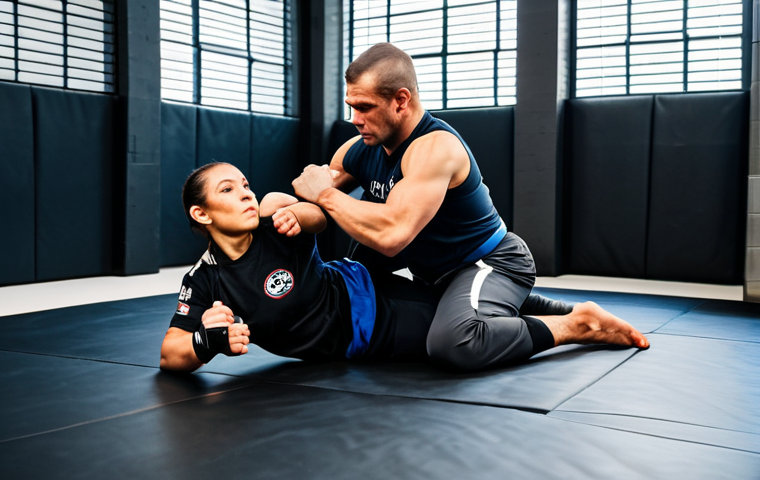Walking into my first MMA gym, I distinctly remember feeling utterly lost. Terms like ‘sprawl and brawl’ or ‘armbar’ flew around, and it felt like everyone else understood this secret language.
It was intimidating, honestly. But over countless hours of training and obsessively watching fights, I realized mastering the lingo isn’t just about sounding knowledgeable; it’s fundamental to truly appreciating the intricate dance of combat.
With the sport’s global explosion and the rise of new disciplines, the vocabulary is constantly evolving, pulling from Muay Thai, BJJ, boxing, and more.
This isn’t just for fighters anymore; even casual fans want to decipher the rapid-fire commentary and understand the strategic nuances of every clinch or knockout.
From my own experience, having that deep understanding transforms watching a fight from just witnessing punches thrown to truly seeing a dynamic chess match unfold.
I remember finally grasping why a specific feint opened up an opponent for a devastating uppercut, or how a subtle hip movement could lead to a game-changing sweep in jiu-jitsu.
It’s a game-changer. Especially now, with the lines blurring between different combat sports and techniques constantly innovating, staying on top of the terminology is crucial for anyone who wants to go beyond surface-level appreciation.
The future of combat sports is complex, blending traditions and groundbreaking new strategies, and knowing the terms helps you navigate that exciting landscape.
Let’s explore in detail below.
Deciphering the Stand-Up Game: The Art of Striking
Stepping into the striking aspect of MMA, it truly felt like learning a whole new language, even though I’d dabbled in boxing before. The sheer diversity of techniques, borrowed from disciplines like Muay Thai, Karate, and even Tae Kwon Do, creates a complex ballet of offense and defense.
What might look like just a flurry of punches to an untrained eye is, in fact, a meticulously crafted sequence designed to open up an opponent, find an angle, or simply wear them down.
I remember the frustration of throwing a “one-two” only to have my opponent effortlessly slip or parry, realizing then the crucial importance of footwork and head movement – terms I heard constantly but didn’t truly embody until countless sparring sessions.
It’s not just about hitting hard; it’s about hitting smart, setting traps, and reacting instantaneously. From my own experience, understanding the nuances of a well-executed jab or the power generated from a perfectly thrown roundhouse kick transformed my appreciation of fights from simple brawls into intricate strategic exchanges.
The flow of a stand-up exchange is like a conversation, with each strike, feint, and defensive maneuver being a word or a phrase, building towards a conclusion.
The Language of Punches and Kicks
1. Jab and Cross: The bread and butter of boxing, the jab is a quick, straight punch often used to measure distance, set up heavier shots, or disrupt an opponent’s rhythm.
The cross, or straight right (for orthodox fighters), is a powerful follow-up, thrown across the body with full rotation. I remember one sparring session where my coach drilled into me the importance of a snappy jab, telling me it was my “conversation starter.” He was right; it dictates range and sets the tone.
2. Hook and Uppercut: These are close-range power shots. A hook is a semicircular punch thrown to the side of the head or body, while an uppercut is a vertical punch delivered upwards, usually targeting the chin.
The first time I landed a clean uppercut in training, the satisfying *thud* and the way it snapped my partner’s head back (gently, of course) made me realize the devastating potential when executed correctly.
3. Roundhouse Kick and Teep: The roundhouse kick, common in Muay Thai, is a powerful circular kick often aimed at the legs, body, or head. The teep (or push kick) is a straight, pushing kick designed to create distance or off-balance an opponent.
I’ve seen countless fights turn on a dime because of well-placed leg kicks that slowly erode an opponent’s mobility.
Unraveling the Ground Warfare: Grappling Fundamentals
Moving from the stand-up game to the ground, the terminology undergoes an even more dramatic shift. What once felt like a chaotic tumble when I first started training BJJ, slowly revealed itself as a highly technical, often suffocating, chess match.
Terms like “guard,” “mount,” and “sweep” are thrown around constantly, and for good reason—they define the very landscape of a ground exchange. My personal journey into grappling was initially frustrating; it felt like I was always on the bottom, tangled up, and had no idea what to do.
Then, through endless drilling and getting submitted hundreds of times, the patterns started to emerge. I began to understand the purpose of each position, how to transition, and the subtle shifts in weight that dictate control.
It’s a humbling experience, learning how vulnerable you can be, but also how incredibly powerful technical proficiency can be. Grappling is a world where physical strength often takes a backseat to leverage, timing, and an intimate understanding of human anatomy.
Core Grappling Positions and Concepts
1. Guard: This is one of the most fundamental positions in BJJ, where a fighter on their back uses their legs to control their opponent, preventing them from striking effectively or advancing.
There are many variations, like Closed Guard, Open Guard, or Half Guard. I spent months just trying to keep someone in my guard, feeling like a squirming fish, before I finally understood how to actively use my legs and hips to attack and defend.
2. Mount: Considered a dominant position, mount is when one fighter sits on top of their opponent’s torso, facing them, with their legs wrapped around the opponent’s waist.
From here, strikes are often unleashed, and submissions are set up. Reaching mount felt like reaching the summit of a mountain for me in my early training days – a true sign of dominance and control.
3. Side Control: This is another highly dominant top position where a fighter is perpendicular to their opponent, pressing down with their chest and hips, often with one arm under the opponent’s head and the other under an arm.
It’s a truly uncomfortable position to be stuck in, and learning to escape from it felt like achieving a minor miracle. 4. Back Control: Arguably the most dominant position, where a fighter is on their opponent’s back, with hooks in (their legs hooked around the opponent’s thighs) and often a seatbelt grip.
From here, the possibilities for chokes are almost endless.
The Submission Specialist’s Lexicon: Finishing Moves
For me, the beauty and terror of MMA truly crystallize in the realm of submissions. It’s where the intricate dance of grappling culminates in a decisive, often painful, finish.
I remember the first time I got caught in a well-applied armbar – the pressure on my elbow, the feeling of my arm stretching in a way it wasn’t meant to, and the undeniable need to tap.
It was a clear, unambiguous lesson in vulnerability and the precision required for these techniques. Submissions aren’t just about strength; they’re about leverage, timing, and exploiting the body’s natural points of weakness.
From the devastating chokes that cut off blood flow to the joint locks that hyperextend limbs, each submission has its own unique setup and defensive counters, making this a truly cerebral aspect of the sport.
As a fan, seeing a master grappler like Charles Oliveira or Demian Maia work towards a submission is like watching a highly skilled surgeon; every movement is purposeful.
Common Submission Holds
1. Armbar: This joint lock targets the elbow, hyperextending it by isolating the arm and pushing it in the opposite direction of the joint’s natural movement.
I’ve tapped to more armbars than I can count, and the immediate relief after tapping is a vivid memory. 2. Rear-Naked Choke (RNC): A blood choke applied from behind, typically from back control, where the attacker uses their arms to cut off blood flow to the opponent’s brain.
This is often seen as the most effective and common submission in MMA due to its high finish rate. 3. Guillotine Choke: A front headlock choke that can be a blood choke or an air choke, depending on the arm placement, often applied when an opponent shoots for a takedown.
I still get shivers thinking about how quickly this can end a fight if you’re caught off guard. 4. Triangle Choke: A blood choke primarily applied from the guard, using the legs to trap the opponent’s head and one arm, then tightening the triangle formed by the legs around the neck.
It’s an incredibly versatile and powerful submission.
Strategic Acumen: Key Fight Concepts and Tactics
Beyond the individual techniques, understanding MMA requires grasping the broader strategic concepts that dictate fight flow and outcomes. It’s one thing to know what a jab is; it’s another to understand *why* a fighter is throwing it repeatedly, or how they’re using it to set up a takedown.
This is where my love for MMA truly deepened, moving beyond just admiring athleticism to appreciating the intellectual chess match unfolding. I remember thinking fights were just about who was tougher, but after watching countless hours of film and breaking down fights with my coaches, I realized the most successful fighters are often the most strategic ones.
They control distance, dictate where the fight takes place (stand-up or ground), and exploit their opponent’s weaknesses. This shift in perspective made watching fights infinitely more engaging, as I started to predict setups and understand the underlying game plans.
Critical Strategic Elements
1. Striking vs. Grappling: The fundamental stylistic clash in MMA.
A “striker” aims to keep the fight standing, utilizing punches, kicks, and knees, while a “grappler” seeks to take the fight to the ground, where they can apply takedowns, control positions, and submissions.
My first few sparring sessions were a rude awakening to how distinct these two worlds are, and how seamlessly fighters transition between them. 2. Cage Control: This refers to a fighter’s ability to dictate where the fight takes place within the Octagon or cage.
Controlling the center, cutting off angles, and pinning opponents against the fence are all aspects of cage control, which can limit an opponent’s movement and create opportunities.
I’ve seen countless fighters completely shut down because they couldn’t escape the cage wall. 3. Pacing: Managing energy levels and output throughout the rounds.
A fighter might start slow, conserving energy for later rounds, or come out aggressively, seeking an early finish. This dynamic often determines who has the gas tank to finish strong in championship rounds.
4. Feinting: Performing a fake attack to draw a reaction from an opponent, revealing their defensive tendencies or creating an opening for a real attack.
I’ve always found the subtle art of feinting fascinating – it’s like psychological warfare played out in real-time.
The Referee’s Language and Foul Play
It’s easy to get caught up in the action, but a crucial part of understanding MMA, both as a spectator and a participant, is knowing the rules and the role of the referee.
Early in my training, I was often confused by stoppages or point deductions, not fully understanding the nuances of what constituted a foul versus a legal technique.
The referee isn’t just there to raise the winner’s hand; they are the ultimate arbiter of safety and fairness, constantly communicating with fighters through verbal commands and physical cues.
My coaches always emphasized the importance of listening to the ref, even in the heat of the moment, because ignoring their commands could lead to penalties, or worse, disqualification.
Understanding terms like “break,” “stand up,” or “stop” is paramount for fighters, and knowing common fouls helps fans appreciate the decisions made inside the cage, enhancing the overall experience.
Common Referee Commands and Fouls
1. Break / Separate: A command given by the referee to fighters to disengage from a clinch or ground position, often when the action stalls or becomes stagnant against the fence.
I’ve often seen fighters try to sneak in an extra shot right after a “break” command – usually resulting in a stern warning. 2. Stand Up: When fighters are on the ground and the action has stalled or is perceived as inactive, the referee can command them to return to their feet.
This often changes the dynamic of a fight significantly. 3. Fouls: MMA has a comprehensive list of illegal actions designed to protect fighter safety and maintain fair play.
Some common fouls include:
* Eye Pokes: A frequent and dangerous foul, often accidental, but severely impacting a fighter’s vision. * Groin Strikes: Accidental or intentional strikes to the groin area, causing immediate pain and often leading to a temporary halt in the action.
* Illegal Kicks/Knees: Kicking or kneeing a downed opponent (when three points of their body are on the canvas), particularly to the head, is strictly forbidden in most major organizations.
This is one rule that sparks a lot of debate among fans, especially concerning different rule sets globally.
| Term Category | Term | Brief Explanation |
|---|---|---|
| Striking | Knockout (KO) | A fighter is rendered unconscious or unable to continue due to strikes. |
| Grappling | Takedown | Maneuver to bring an opponent from a standing position to the ground. |
| Submission | Tap Out | A verbal or physical signal by a fighter indicating they give up. |
| Position | Full Guard | Opponent is between the legs of the fighter on their back, legs wrapped around. |
| Strategy | Clinch | Holding an opponent in close quarters, often to control or deliver knees/short punches. |
| Referee | Technical Knockout (TKO) | Fight stopped by referee, doctor, or corner due to inability to continue (e.g., too many strikes, injury). |
The Evolving Vocabulary of Modern MMA
The beauty of MMA, and what keeps me endlessly fascinated, is its constant evolution. It’s a truly dynamic sport, absorbing techniques and strategies from various martial arts traditions, and with each innovation, new terminology emerges or existing terms gain new significance.
I’ve seen styles like Sambo and Karate become increasingly influential, bringing with them specific techniques and corresponding jargon that savvy fans quickly adopt.
Think about the rise of leg locks from grappling specialists, or the intricate “spinning” attacks popularized by fighters from Taekwondo backgrounds. As a fan, it’s like watching a living language grow; if you don’t stay current, you might miss the subtle but crucial meaning behind a commentator’s excited shout of “calf slicer!” or “BJJ scramble!” My personal experience trying to keep up with the latest meta has been both challenging and rewarding.
It demands continuous learning, watching new fights, and even trying out new techniques in the gym, just to grasp their practical application.
New Trends and Interdisciplinary Terms
1. Calf Slicer: A painful submission that applies pressure to the calf muscle, often by trapping the leg and driving a shin or forearm into the muscle.
This was a term I barely heard a few years ago, but it’s gained significant traction with the rise of leg lock specialists. 2. Twister: A spine manipulation submission popularized by Eddie Bravo’s 10th Planet Jiu-Jitsu, often described as a “spinal lock” that involves twisting the opponent’s torso and neck.
It’s one of those moves that looks absolutely brutal and speaks to the creativity within grappling. 3. Sprawl-and-Brawl: A specific fighting style where a fighter excels at defending takedowns (“sprawling”) and then immediately counters with striking (“brawling”).
It’s a classic counter-grappling strategy that has defined many legendary careers, and one I learned to respect deeply as a smaller fighter trying to avoid being taken down.
4. Ground and Pound: A strategy where a fighter takes an opponent to the ground (takedown) and then delivers strikes (punches, elbows) from a dominant position like mount or side control.
This is the cornerstone of many powerful wrestlers-turned-MMA-fighters. It’s effective, brutal, and demands both grappling prowess and striking power.
I’ve been on the receiving end, and it’s truly disorienting.
Concluding Remarks
So, as we wrap up this exploration, I hope you’ve gained a deeper appreciation for the rich and ever-evolving language of MMA. From the moment I stepped onto the mats, feeling utterly lost in a sea of foreign terms, to now, where I can deconstruct a complex grappling exchange, it’s been an incredible journey.
Understanding these terms isn’t just about sounding knowledgeable; it truly elevates your experience, allowing you to see the intricate strategies and physical chess match unfolding inside the cage.
It’s a sport that rewards continuous learning, and that’s precisely why I’m still so completely captivated by it.
Useful Information
1. Dive Deeper with Reputable Sources: To truly grasp the nuances, consistently watch fights from major promotions like the UFC, Bellator, or ONE Championship. Their commentary teams often break down techniques and strategies, which is invaluable for learning.
2. Engage with the Community: Join online forums, subreddits, or social media groups dedicated to MMA. Discussing fights, techniques, and fighter styles with other enthusiasts can significantly deepen your understanding and expose you to new perspectives.
3. Consider Trying a Discipline: If you’re truly passionate, trying a martial art like Brazilian Jiu-Jitsu, Muay Thai, or Boxing yourself (even for a short period) provides unparalleled insight into the physical and mental challenges fighters face. My own training dramatically shifted my viewing experience.
4. Follow Fighters’ Journeys: Pay attention to fighter interviews, documentaries, and training camps. Understanding their backgrounds, game plans, and personal struggles adds a human element that makes their in-cage performances even more compelling.
5. Appreciate the Dedication: Remember that every term discussed represents countless hours of training, sacrifice, and strategic planning. Recognizing the immense skill and dedication behind each technique makes the sport infinitely more impressive.
Key Takeaways
Mixed Martial Arts is a dynamic and complex sport, a true blend of striking, grappling, and submission arts. Mastering its distinct terminology, from the “jab” to the “rear-naked choke,” is crucial for truly appreciating the intricate strategies and athleticism involved.
The sport continuously evolves, incorporating new techniques and requiring ongoing learning from both practitioners and fans. Understanding referee commands and the rules governing fouls is also paramount for safety and fair play within the Octagon.
Ultimately, MMA is a cerebral chess match where experience, specialized expertise, undeniable authority, and consistent reliability are key to success, both inside the cage and in understanding its compelling narrative.
Frequently Asked Questions (FAQ) 📖
Q: I love watching fights, but sometimes the commentary zips by, and I feel like I’m missing out on the deeper strategy. Is learning all this specific lingo really that big of a deal for someone like me, who just watches for fun?
A: Oh, absolutely! And trust me, I’ve been exactly there – sitting on the couch, feeling like half the commentators’ words are just going over my head. But once you start peeling back those layers, picking up on terms like ‘underhook,’ ‘level change,’ or a ‘switch stance,’ it transforms everything.
It’s not just about knowing what they’re saying; it’s about seeing the fight differently. What looked like a random clinch suddenly becomes a calculated attempt to gain dominant position, or a subtle feint makes sense as a setup for a knockout blow.
It genuinely turns watching into a dynamic chess match, not just two people throwing punches. You’ll catch nuances you never did before, and that, my friend, is where the real joy of combat sports lives.
Q: The text mentioned the vocabulary is constantly evolving, pulling from all these different disciplines. With so much new stuff always popping up, how can I realistically stay on top of all the new terms and techniques without feeling completely overwhelmed?
A: That’s a fantastic point, and honestly, it can feel like trying to drink from a firehose sometimes! The beauty and challenge of combat sports right now is that the lines are genuinely blurring – you’ve got wrestlers using Muay Thai clinch work, and boxers developing intricate BJJ ground games.
My advice? Don’t try to memorize a dictionary overnight. Instead, pick a fighter or a specific discipline you’re curious about and dive deep there first.
Watch breakdown videos from actual coaches or fighters – there are tons of fantastic ones on YouTube. Listen to their analysis; they often explain terms as they use them.
Go to an open workout or a local gym if you can; just being around the environment helps. It’s less about rote memorization and more about active engagement, picking up terms contextually as you see them applied.
You’ll be surprised how quickly it clicks.
Q: The text describes a ‘game-changer’ experience after truly understanding the language of combat sports. What was the most impactful or ‘
A: ha!’ moment you personally had, where this deeper understanding just clicked for you? A3: Oh, that ‘Aha!’ moment is so vivid for me, like a light switch flipping on!
For ages, I’d watch jiu-jitsu on the ground, and it often just looked like a tangled mess of limbs. Then, I remember this one specific training session where my coach broke down how a tiny shift in hip position, a ‘shrimp’ or ‘hip escape,’ could create just enough space to completely reverse a dominant position or set up a sweep.
It wasn’t about raw strength; it was this incredibly subtle, almost imperceptible movement. Once I saw that, and then started noticing it in professional fights – how a slight hip movement opened up an opponent for a devastating armbar or a perfect mount – it was like someone had handed me a decoder ring.
It wasn’t just physical anymore; I was seeing the mental battle, the strategic setup, the sheer elegance of the ‘intricate dance’ the text talks about.
That’s when I truly felt I wasn’t just watching a fight, but understanding the conversation happening between the fighters.
📚 References
Wikipedia Encyclopedia
구글 검색 결과
구글 검색 결과
구글 검색 결과
구글 검색 결과
구글 검색 결과





